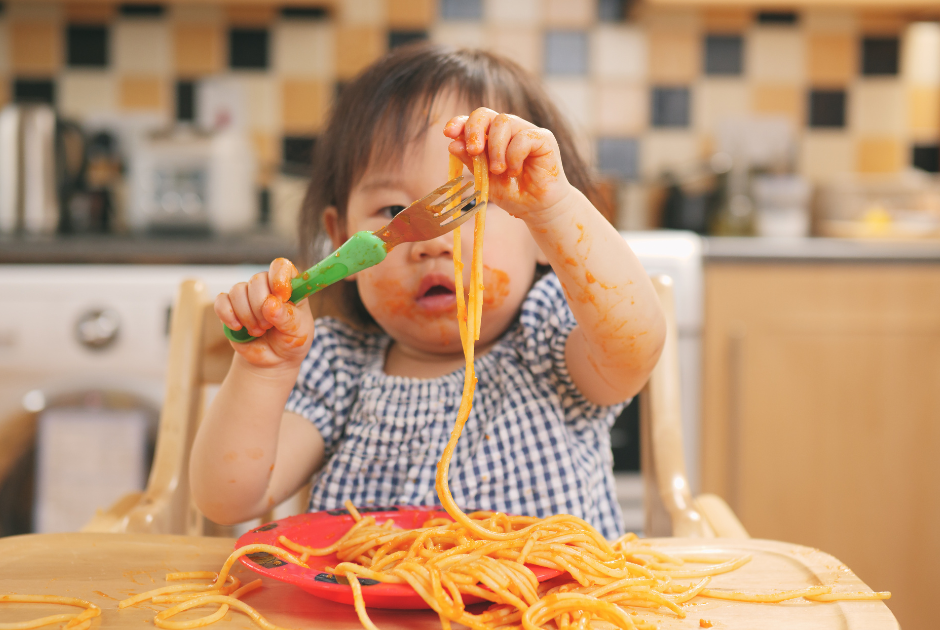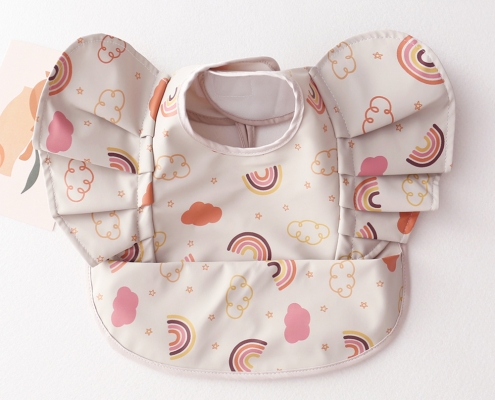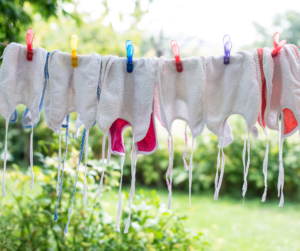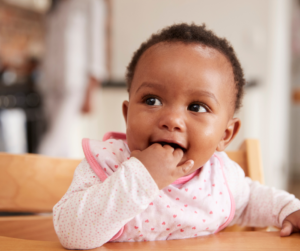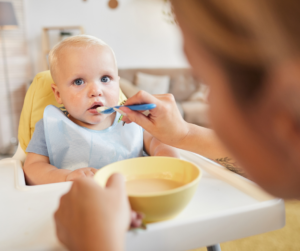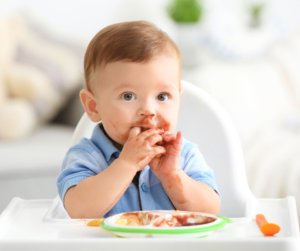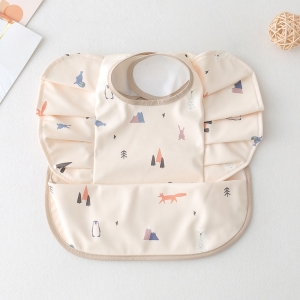Keeping a Feeding Bib Clean: Tips and Tricks for Tidy Feeding
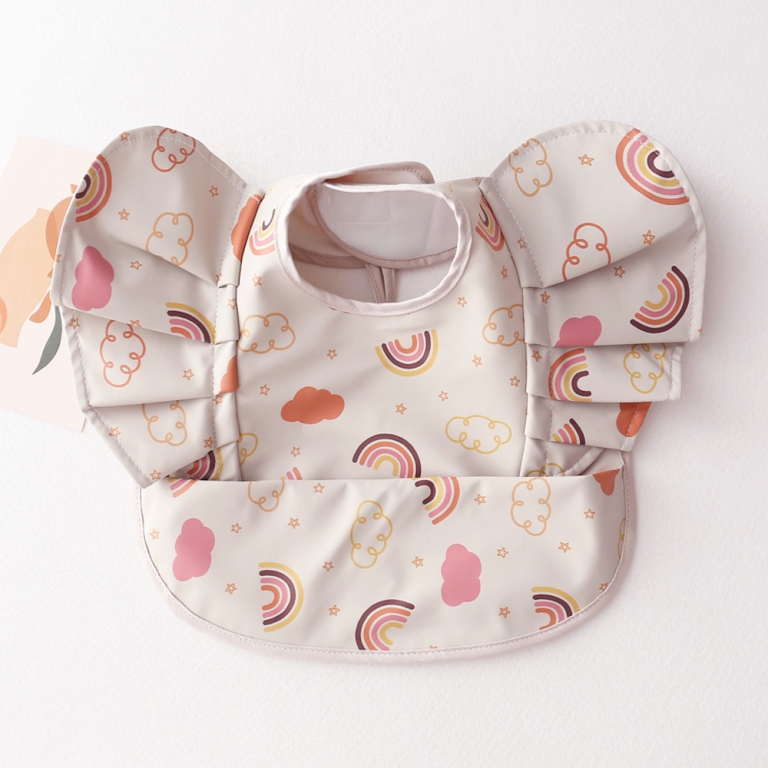
Feeding your little one can be a delightful and sometimes messy experience. Bibs are a parent’s best friend, catching all the spills and dribbles that come with mealtime. We’re going to talk about keeping your feeding bib clean today, but first let’s get the lowdown on bibs.
The Feeding Bib Lowdown – The Essentials You Need To Know
How Many Bibs Do I Need?
The number of bibs you’ll need largely depends on your baby’s age, how often you do laundry, and your baby’s feeding habits. In general, it’s a good idea to have several bibs on hand, especially if your baby is in the messy-eating phase. Newborns might need fewer bibs, but as they start exploring solid foods, you’ll want to stock up. A general rule of thumb is to have at least 5-7 bibs in rotation. This way, you can use one for each meal and have a few spares in case of emergencies.
Types of Bibs
Do you ever get a bit confused about the different names used for bibs? It can be a bit confusing! There’s a wide variety of bibs available, each designed to suit different needs and ages. Here are some common types:
Traditional Cloth Bibs: These are the classic bibs made of soft, absorbent materials like cotton. They’re great for catching drool and spit-up and are easy to toss in the washing machine.
Waterproof Bibs: Perfect for messy eaters, waterproof bibs are usually made from materials like vinyl or plastic. They protect your baby’s clothing from spills and are easy to wipe clean.
Silicone Bibs: Silicone bibs are a popular choice for their durability and easy cleaning. They’re waterproof, come with a pocket to catch crumbs, and are suitable for both feeding and teething.
Sleeved Bibs: These bibs have long sleeves to provide maximum coverage. They’re excellent for messy eaters or babies who enjoy self-feeding.
Bandana Bibs: As stylish as they are functional, bandana bibs offer a trendy look while keeping your baby dry from drool. They’re often made of soft, absorbent fabrics.
Disposable Bibs: These are convenient when you’re on the go. They’re easy to pack, use, and toss, making them perfect for travel.
Feeding Bibs: Designed specifically for mealtime, feeding bibs are usually larger and provide full coverage. They often come with a pocket to catch food crumbs and spills.
At Little Pom Pom, we stock the most adorable ruffle-sleeved feeding bibs you’ll ever see! It’s important though, with all of these bibs, that to keep them effective and safe for your baby, we know how to keep our feeding bibs clean. In this blog, we’ll explore some handy tips for maintaining bibs, from preventing unpleasant odours to tackling stubborn stains and more. Let’s dive in!
How Do I Keep My Bib from Smelling?
Keeping a bib smelling fresh is essential for your baby’s hygiene and comfort. Here are some steps to prevent unpleasant odors:
Rinse Immediately: After each meal, rinse the bib thoroughly under cold water to remove food residues.
Pre-Treat Stains: If your baby’s meal leaves behind stubborn stains, apply a stain remover or a mixture of vinegar and water before washing.
Frequent Washing: Regularly wash your bibs to prevent the buildup of odours and stains.
Air Dry: After washing, allow the bib to air dry in the sun or a well-ventilated area. Sunlight can naturally eliminate odours.
Stopping a Bib Going Mouldy
Mould can be a concern, especially in humid environments. To prevent a bib from going mouldy
Dry Thoroughly: Ensure the bib is completely dry after each use. Mould thrives in damp conditions.
Store Properly: Hang the bib to air out, or store it in a dry and well-ventilated area.
Regular Cleaning: Don’t leave dirty bibs for extended periods. Mould is less likely to develop on clean bibs, so put all bibs into the wash straight after one use!
How Do You Disinfect Baby Bibs?
Disinfecting baby bibs is crucial to maintain hygiene. Here’s how to do it:
Use Hot Water: Wash the bibs in hot water, preferably at a temperature of 60°C (140°F) or higher.
Disinfectant Solution: Soak the bibs in a disinfectant solution according to the product instructions.
Sunlight: Sunlight is a natural disinfectant. After washing, let the bibs dry in the sun.
Do I Need to Wash New Baby Bibs?
Yes, you should always wash new baby bibs before using them. This helps remove any manufacturing residues and ensures the bib is clean and safe for your baby.
Can You Sterilise Silicone Bibs?
Yes, silicone bibs can be sterilised. You can sterilise them by placing them in boiling water for a few minutes or using a steriliser designed for baby products. Always follow the manufacturer’s instructions.
Are Bibs Machine Washable?
Most baby bibs are machine washable. Check the care label on your bib for specific washing instructions. In most cases, it’s recommended to wash them on a gentle cycle.
How Do You Get Yellow Stains Out of A Feeding Bib?
Yellow stains can be challenging to remove. Here’s a method to help:
Lemon Juice: Soak the stained area in lemon juice for about 15 minutes.
Rinse: Rinse the bib with cold water.
Wash: Wash the bib as usual, and dry in the sun.
How Do You Clean Waterproof Bibs?
Cleaning waterproof bibs is relatively simple. Just wipe them down with a damp cloth or rinse them under running water. For stubborn stains, use a mild soap or baby-friendly detergent.
Are Silicone Bibs Safe for Newborns?
Silicone bibs are generally safe for newborns. They are easy to clean, waterproof, and comfortable for your little one. Always choose a bib specifically designed for newborns.
Storing Baby Bibs
To keep your bibs organised and clean:
Hang Them: Use hooks or hangers to hang bibs in a convenient location.
Drawer or Basket: Store clean bibs in a drawer or a basket to prevent dust or dirt buildup.
What Are the Yellow Stains on My Feeding Bib? And Black Spots on a Bib!
Yellow stains on baby bibs are often caused by food or formula residue. Black spots can be mould. Follow the cleaning and prevention tips mentioned earlier to deal with both issues – we really want to avoid these stains being on our bibs, as they might affect baby’s health.
Maintaining clean bibs is not just about appearance but also about your baby’s well-being. A clean bib ensures your baby stays comfortable and healthy during mealtime. At Little Pom Pom, we understand the importance of quality baby accessories, including feeding bibs, for a happy and healthy parenting journey. Check out our range of feeding bibs here
Share this entry



